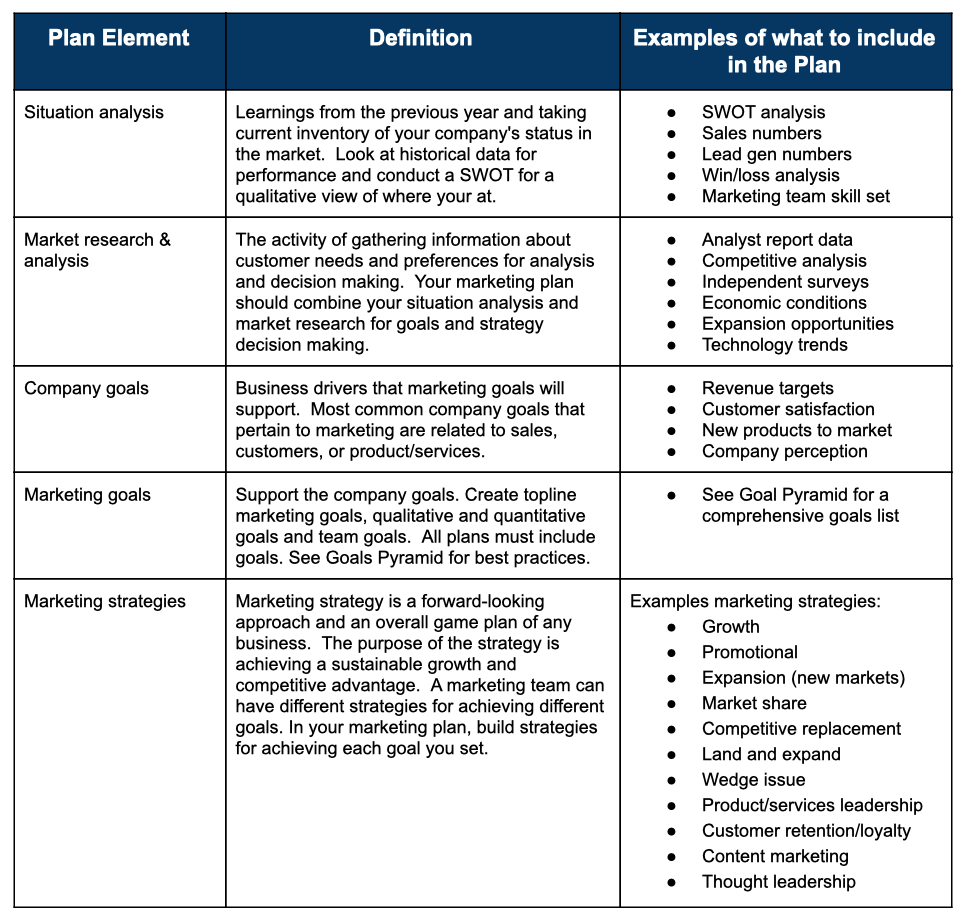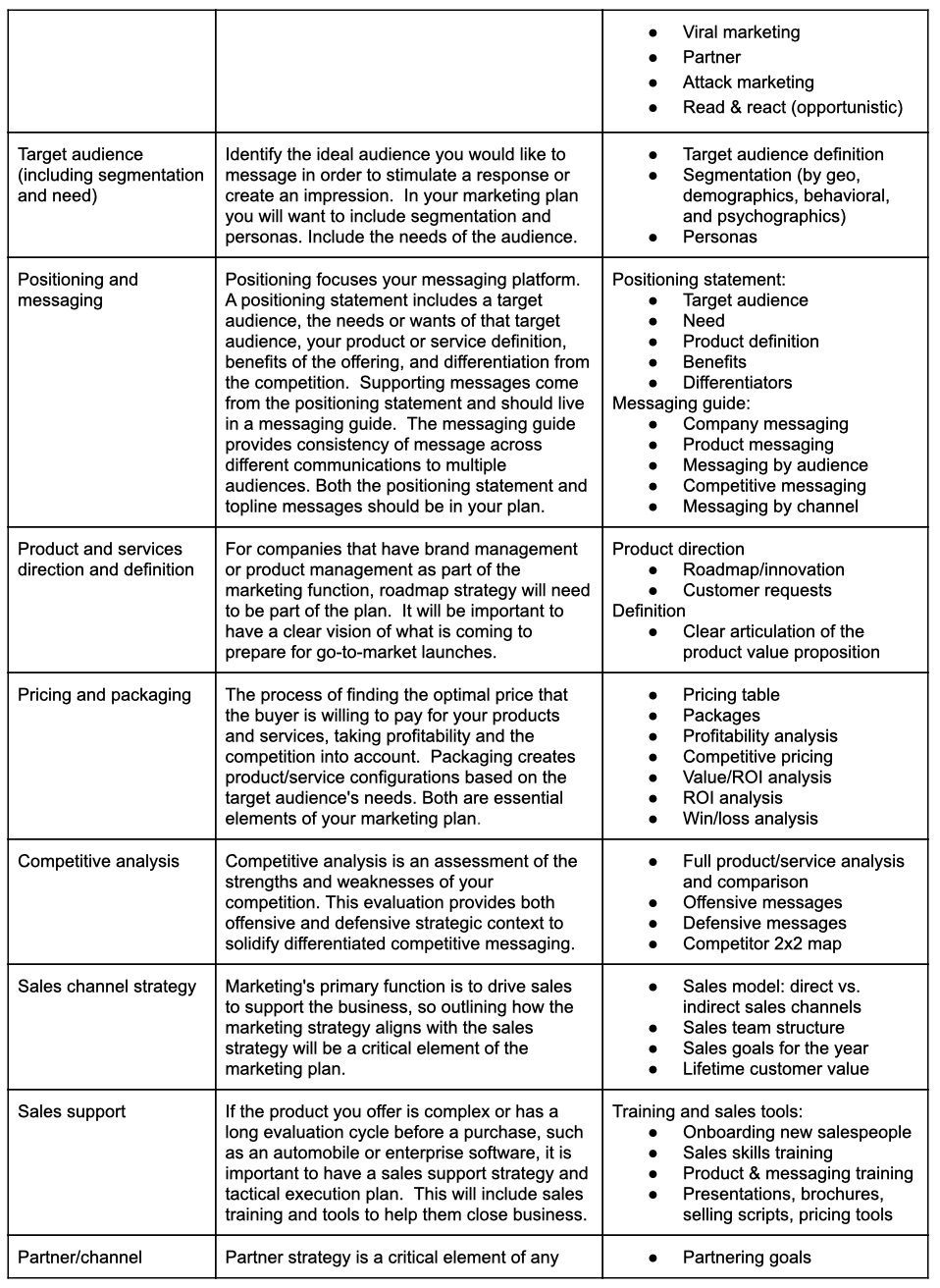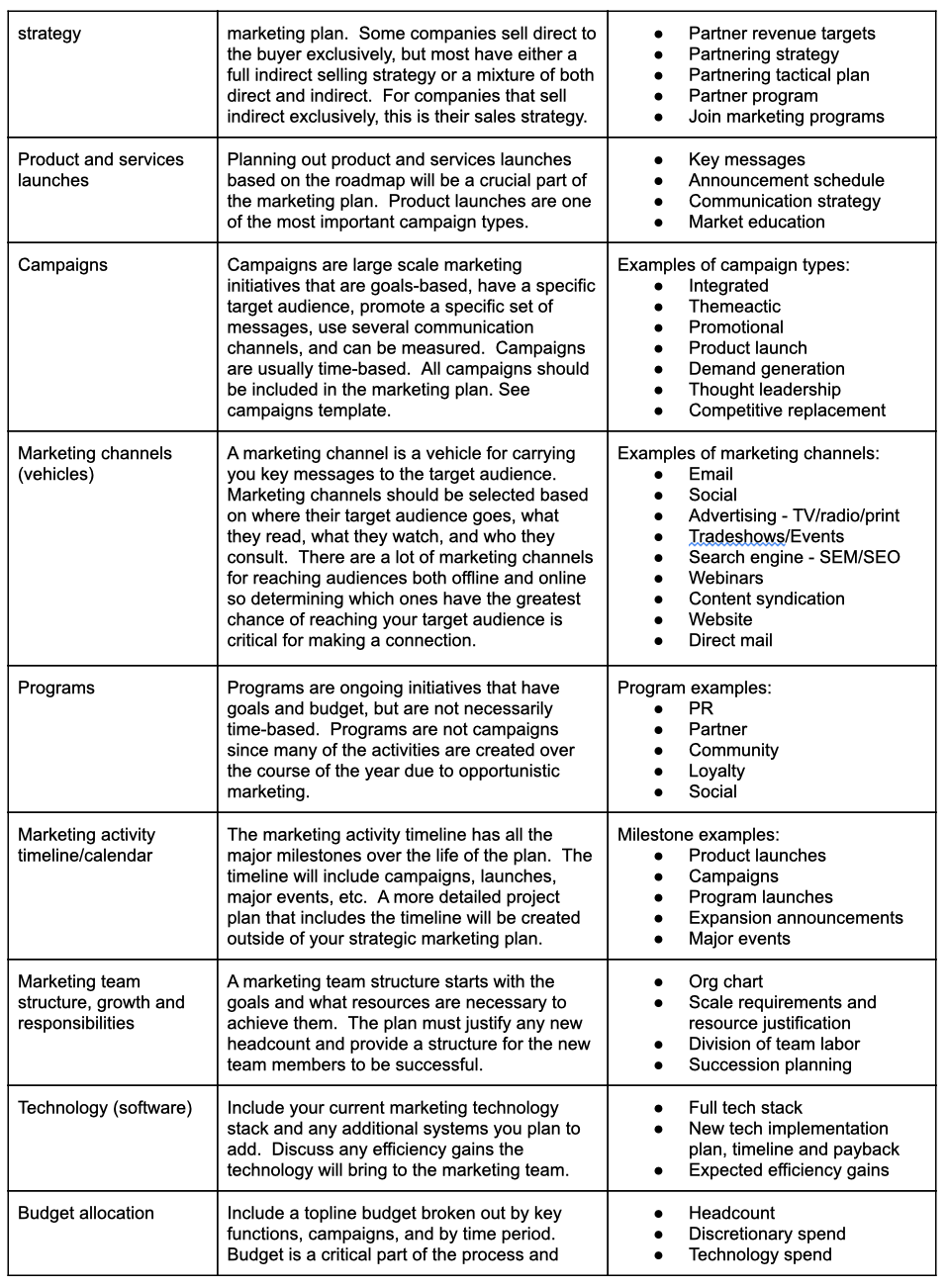Ch 6: Building Winning Marketing Plans

Don’t half-bake your marketing plan, it’s the most important thing you will do all year
As marketers we understand that a marketing plan is the most important and strategic document we will produce all year. The problem is we don’t always treat it as such. For many of us, the urgent seems to get in the way of the important and we end up rushing to complete our plans at the end of the year to make deadlines associated with executive team presentations. We often create the plans in silos with little input from sales or the product team. For those of you who have been with a company for more than a year, were you lazy and started with last year’s plan and built the current plan off of it? Be honest.
CMOs that have teams with more than 5 marketers usually have several functions to manage. The problem is that each of these functions are often focused on what they do well and not the greater goals. For this reason marketing teams can have misaligned goals and campaigns tend to be function-specific rather than focused on the target audience and message. This dramatically impacts the effectiveness of the marketing plan.
Even when you have a plan, the team doesn’t always follow it or know how to apply it to their function. How many times in the middle of a planning cycle have you heard an event’s person say, “I think we should run a dinner series” without any context to the plan or why or with who? Or a digital marketer says “Let’s do an email program to the database” without thinking about segmentation or tying it to campaigns outlined in the plan? These are one-off tactical activities that are marketing-channel specific. More probable than not, these efforts failed, or at least did not meet expectations. The question is, why?
Why Marketing Plans Aren’t Followed
There are five primary reasons why marketers run rudderless marketing activities and do not follow the plan:
- The plan that was built at the beginning of the year was not detailed enough for the team to use as a guide for their efforts
- The team never fully understood how the strategy fit with their function so they defaulted to what they know how to do instead of doing what aligns with the goals and strategy
- The plan was solid, but it resides in a presentation deck somewhere, never to be seen again
- Each member of the team built his or her own plan, and those were never integrated across the functions
- There wasn’t a comprehensive, goals-driven plan
If there wasn’t a plan in place, which unfortunately happens far too often, then there will probably be a change in marketing leadership soon. All of the other scenarios listed above are direct failures of the CMO not setting a clear strategy, getting team buy-in, and continually reinforcing the direction by revisiting the plan.
To ensure you do not get caught in the busywork marketing cycle and are aligned with the marketing strategy, there are a series of questions you need to ask when new ideas, campaigns and programs come to light:
What is the goal we are trying to accomplish?
- What is the right strategy to accomplish this goal?
- Who is the target audience?
- What are the messages we want to deliver to that target audience based on their needs?
- Does this tie into a larger theme?
- What are the metrics of success?
If the answers align with the current plan and you are practicing an agile marketing approach, then you should consider the new initiative. But caution, if the conversation gets tactical and stuck on the marketing channel of delivery without providing answers consistent with your plan, walk away.
A best practices framework toward building a marketing plan
Let’s take a step back and talk about the definition of a marketing plan. In early 2020, Wikipedia offers the following:
A marketing plan may be part of an overall business plan. Solid marketing strategy is the foundation of a well-written marketing plan so that goals may be achieved. While a marketing plan contains a list of actions, without a sound strategic foundation, it is of little use to a business.
After reading that definition, maybe this is why marketing is of “little use to the business.” When done correctly, there is no “may be part of an overall business plan,” it is a large portion of the business plan. And you need to think and prepare that way.
Companies that sell to consumers (B2C) usually view marketing as the most strategic function at the organization. For companies that sell to other businesses (B2B), marketing can be viewed as a support function for sales. In either case, the foundation for the marketing plan is the same: you need to identify the right buyer who has a need for your product, and you need to deliver a compelling message to inspire them to purchase.
Every comprehensive marketing plan should include the following strategic marketing elements—in this order—to build off each other:
- Situational analysis (historical data)
- Market research and analysis
- Company goals
- Marketing goals (roll-up to company goals)
- Marketing strategies
- Target audience (segmentation and need)
- Positioning and messaging
- Product and services direction and definition
- Pricing and packaging
- Competitive analysis
- Sales channel strategy (distribution model, customer acquisition and lifetime value)
- Sales support (messaging, training, tools)
- Partner/channel strategy
- Product and services launches
- Campaigns
- Marketing channels/vehicles (PR, trade shows, social, email, website, direct mail, etc.)
- Programs
- Marketing activity timeline/calendar
- Marketing team structure/growth/responsibilities (org chart)
- Technology (software)
- Marketing budget management & allocation
- Testing (messages, ideas, markets)
- Metrics of achievement
- Assumptions, dependencies, risks
Unless you are the head of marketing or marketing operations, you may not be responsible for all these plan elements. However, every person plays a part in the success of the plan, so work with your team to carve out your role.
The Marketing Plan Framework
The following proposed Marketing Plan Framework (MPF) and template offers a definition for each plan element and examples of what to include in the plan:




It might look like a daunting task to think through all of the elements of the marketing plan list above. But, if you build the plan in collaboration with your marketing team, collectively everyone will be focused on what is important instead of marketing in silos. Planning is the first step toward becoming an agile marketer.
Nothing ever goes exactly according to plan: build a plan that flexes to take advantage of opportunities and changing market conditions

Did your plan get punched in the mouth?
You and your team have just built the best plan ever using the Marketing Plan Framework (MPF) outlined in this chapter. The plan you built fully aligns with the goals as they stand today and details a comprehensive strategy for achieving them. You start executing the plan to perfection and then out of nowhere the roadblocks to success start to appear. Before you know it, you are off course.
The list of reasons why your plan can crumble is long. Below are some common causes:
- Economic volatility causes budget cuts
- Competition comes out with a new and improved product or revised pricing
- You have employee turnover of key marketers on your team
- Your plan isn’t achieving the stated goals
- The sales team is not prepared to do its part
- The CEO changes the company direction
- The R&D team does not hit its release dates
- The industry you sell to starts drying up
- You fail to get traction in a new geography
- You have to overspend on a campaign so you need to modify the plan
- The team does not understand or buy into the plan
- You hire the wrong skill set or onboard someone late, creating a capacity gap
- New hires don’t pan out, leaving you shorthanded
- Vendors you hire don’t understand the plan and have misaligned output
- The sales team decides to take a different approach or direction
- Your partners do not hold up their end of the bargain
- Lead generation emergencies arise and distract the team
- Campaigns and programs get delayed creating a ripple effect downstream
- Major marketing events get cancelled
- Marketing leadership changes
How many of these have you experienced? Hopefully this list did not send a chill up your spine, but these are the key contributors as to why CMOs have the shortest lifespan in the C-suite. So what does this mean? It means you need to build a plan that is flexible and prepares for different scenarios. In other words, you need to build an agile marketing plan.

Why do you need to need to be agile? Because stuff happens—both good and bad. In either case, your plan can get back burnered while full effort is put toward taking advantage of the new opportunity or resolving the current issue at hand. All too often, after the disruption subsides, the plan is derailed and the team engages in rudderless marketing activities hoping that something works. The problem is that hope is not a strategy, and more often than not, this only results in unachieved goals.
An agile marketing plan is made up of 3 key components:
- Flexing for opportunistic marketing
- Underachievement scenario planning
- Overachievement scenario planning
Flexing for Opportunistic Marketing
Depending on your company size, numerous unplanned opportunities will emerge over the course of the year, such as: a customer wants to do a press release with you, an industry analyst ranks your product or service the best on the planet, or a partner wants to OEM your product and do joint marketing.
In marketing, you are constantly working with the outside world. The problem is that you can’t control what these external audiences do or the timing of the opportunities they place at your feet. You can only control your end of the equation.
Typically there are three reasons you pass on unplanned opportunities: timing, resources, and budget. But if you have that information at your fingertips, then you can quickly compare a new opportunity against the current plan to determine which will have more impact on the goals. For this reason, the key steps to the evaluation process are:
- Assess if the opportunity helps to achieve the annual marketing goals and is executable
- Prioritize by comparing new opportunities against existing marketing campaigns
- Collaborate with the team to plan for new opportunities and modify existing campaigns
- Reallocate funds accurately without going over budget
- Re-engage with the original plan to get back on track
A word of caution: Don’t let frequent urgent opportunities distract you from the original goals-based plan, but be flexible if the opportunity is too good to pass up.
Scenario Planning for Under- and Overachievement
When building an agile marketing plan, start with your baseline plan (the one that was built to achieve the original company objectives) and use it as a barometer to build your scenarios— these are a set of restated goals, either up or down, determined by business outcomes that deviate significantly from the original objectives. These scenario-based goals have a material impact on the marketing plan’s strategy, campaigns, and budget. The purpose of scenario planning is so that when you recognize changes in the business, you have a pre-built plan to quickly course correct.
When creating scenarios, the first step is to define a new set of goals based on under- or over-performance. Once the objectives are established, create a set of goal-based scenarios that are triggered by pre-defined potential outcomes. These scenarios are designed to either prepare you for dealing with bumps in the road that cause under-performance, or leverage over-performance to supercharge your marketing.
For underachievement, it’s not necessary to create more than one scenario, but having two [slight underachievement (25%) and significant underachievement (50%)] is recommended if your business has variability or ambitious goals. If you feel there is a chance underachievement could be greater than 50%, you may want to redo your original plan. Companies with this level of variability are usually start-ups or businesses with little to no historical data.
For conservative marketing plans with potential revenue upside, you might want to also look at an overachievement scenario. When building this, check with the CFO to confirm that if revenue targets are exceeded, marketing will receive some of the proceeds for additional programs. Ideally you will want to leverage the newly acquired funds (house money) to conduct experiential marketing initiatives aimed at expanding your current repertoire of campaigns and programs.
7 Steps for Building & Executing Scenarios
There is a seven step process for building and executing scenarios:
- Identify the driving forces behind the potential risks, issues, or decisions
- Determine the impact to the current goals
- Create a new set of goals that map to underachievement or overachievement
- Rank the strategies, campaigns and programs by criticality (highest impact to the business), keeping in mind budget thresholds (especially in case of cuts)
- Align the ranked marketing initiatives to the scenarios based on severity up or down
- Assign a numerical ranking or categorization such as keep, consider, cut
- Build a tiering structure based on the level of under or overachievement
- Select metrics for monitoring and create thresholds for when scenarios are triggered
- Assess the impact of switching to the scenario and adjust accordingly to alternative strategies
Alternative strategies for overachievement are limitless, but when you underachieve, human and financial resources usually get tight. There are some inexpensive marketing options to explore if you have to put together an underachievement plan. Switching from paid to free marketing is the best place to start. Strategies such as content, social, viral, word of mouth, and joint marketing with partners (splitting marketing expenses) can be very cost effective and will stretch your discretionary spend. If the cuts are primarily to headcount, reallocating financial resources to AI-related marketing planning software can create lots of efficiencies across the board. You can also look at cheaper offshore vendors for activities such as design, SEM, and telemarketing.
If you don’t want to wait until next week to read the next chapter you can download the full book here.
And learn more about Plannuh’s marketing resource management software.
{{cta(‘3f34ef64-f9ae-475f-b272-6f35d3e0c322′,’justifycenter’)}}

